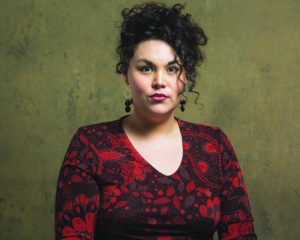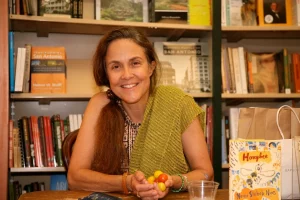#75: Wednesday, January 25, 2023
“Skin” – composed by Mari Esabel Valverde
Poetry by Naomi Shihab Nye
SSAA, piano
Are you looking for a brand-new piece for your SSAA ensemble? Something lush and sweeping, with thought-provoking text? Composed by, and using the poetry of, two wonderful women with diverse, expansive, multi-faceted backgrounds? Then read on!
 “Skin” is a new choral work by Mari Esabel Valverde, for SSAA voices and piano. It was commissioned as part of a consortium project, by a group of 14 ensembles. [If you have the opportunity to join in to a composition consortium – either through a publisher or a composer – I highly encourage it!] All the groups share the exclusive right to perform the piece for now – but it will be available to the general public starting September 1, 2023. So, if you’re thinking ahead for next year’s programming, this piece is a must to consider.
“Skin” is a new choral work by Mari Esabel Valverde, for SSAA voices and piano. It was commissioned as part of a consortium project, by a group of 14 ensembles. [If you have the opportunity to join in to a composition consortium – either through a publisher or a composer – I highly encourage it!] All the groups share the exclusive right to perform the piece for now – but it will be available to the general public starting September 1, 2023. So, if you’re thinking ahead for next year’s programming, this piece is a must to consider.
 The poetry for the work, “Two Countries,” is from Naomi Shihab Nye, in her collection Words Under the Words (1995). Nye was born to a Palestinian father and a German American mother and grew up in both the central West Bank and San Antonio, Texas. Her lived experience of existing in multiple places with multiple cultural identities, in multi-national, multi-cultural homes and places, is evident in her writings. You can read the full poem here: https://poets.org/poem/two-countries
The poetry for the work, “Two Countries,” is from Naomi Shihab Nye, in her collection Words Under the Words (1995). Nye was born to a Palestinian father and a German American mother and grew up in both the central West Bank and San Antonio, Texas. Her lived experience of existing in multiple places with multiple cultural identities, in multi-national, multi-cultural homes and places, is evident in her writings. You can read the full poem here: https://poets.org/poem/two-countries
Mari’s composer’s notes in the score set the tone for the entire work:
“”Skin” addresses themes of healing, resilience, passage, and travel. Without mention of any particular name, age, gender, or race, the protagonist “Skin” acknowledges past traumas and ultimately expresses a profound feeling of gratitude “that there are travelers, that people go places larger than themselves.” … A single line of text is sung twice, “Love means you breathe in two countries,” in honor of the two worlds indicated in the title of the poem. …because we have the capacity to heal, we need not abandon a part of ourselves when we move to nourish another part of humanity thirsting for life.”
Meter: The musical setting moves seamlessly between 6/4 and 3/4. Some 6/4 measures feel in 2 (3+3), while others feel in 3 (2+2+2). The 3/4 measures are usually a one-sided continuation of the 6/4, as a slow 1, but can also be a deliberate 3, transitioning from one text moment to another.
As conductor, you can micromanage the meter, showing every individual beat and clear pattern, which arguably can be helpful during the initial learning process. But the real nuance of the piece is found in the “big beats.” Feeling the floating half note, or the dotted half note, is key to the true flow of the musical line. Making sure singers know when to feel half vs dotted half (2+2+2 vs 3+3) in the 6/4 sections is a great team exercise early on – looking at text stress and slurs and phrase markings to determine the right choice.
Rhythms are straightforward. There is minimal beat division – only the occasional dotted quarter+eighth, or entrance on the ‘and’ of a beat. No subdivisions or heavy syncopation. The inspiring text is cleanly set, with ample opportunity for the audience to understand the lyrics clearly.
Mari’s setting is tonally and harmonically varied. The end result is an amazing sound, but solfege is likely not a great option here, unless your ensemble is really good at reading non-diatonic rep. For reference, we started on solfege for the first few measures, but then moved away when the accidentals started making an appearance. We went back to solfege at a few points in the song, but not often. The piece begins on a unison C, but quickly shifts tonal centers, working in C-major, and a-minor, but also a number of other tonic frameworks throughout.
The piano accompaniment is supportive – always present but never overbearing. It brings helpful harmonic underpinnings, without doubling the voice lines. While the voice lines rarely have beat-division (eighth notes), the piano frequently utilizes beat division to propel the work forward. The accompaniment is rhythmically purposeful and driving, without being accented or pushy.
Voicing in the work ranges from unison to 4-part homophony to 2-line polyphony (SS+AA or SA+SA) to (infrequent) 4-line polyphony. Many of the voicing changes throughout the work underscore the “two countries” concepts from the text – one idea, shapeshifting to two ideas, back to one idea.
One of my favorite moments in the piece is around m19, where the two soprano lines are in harmony, and the two alto lines are in harmony, and the melodic line moves back and forth from Ss to As – an eloquent handoff that continues for about 10 measures, before coalescing back into full homophony. A similar moment happens at m74, when the focus moves from full homophony to two equal divisions. The groups this time are outside voices (S1/A2) and inside voices (S2/A1). There is octave movement in the outside voices, with a harmonized countermelody in between, eventually shifting back to four voices moving together.
The work wouldn’t be complete without attention to expressive details: dynamics, rubato, and phrase shaping all play a key role in the final design. Mari is very clear in communicating her desires as a composer – the score has many indications of intended dynamic and tempo shifts (but not so many that the score is too complex or busy!). Its a wonderful balance between her communicating her vision as composer, and also giving the piece a chance to breathe new life with each different conductor or performing ensemble.
If you are interested in this piece, or other works by Mari, I encourage you to visit her website at marivalverde.com. [Speaking of other works – she has numerous works for SSA and SSAA ensembles – jump below the video for a complete listing]
This recording below is of the Cornell University Chorus, conducted by Joe Lerangis.
Other SA, SSA, and SSAA works by Mari Valverde:
- De colores (Made in Color) (2022) // text: traditional folk. SA chorus, soprano solo, and piano or SSA chorus and piano, sung in Spanish, ca. 2′
- We Hold Your Names Sacred (2021) // text: Dane Figueroa Edidi. for SSAA chorus (div.) and piano, ca. 4′
- Skin (2020) // text: Naomi Shihab Nye. SSAA chorus and piano, ca. 4′
- When the Dust Settles (2019) // text: Amir Rabiyah. SSAA chorus and piano, ca. 5′
- When Thunder Comes (2017) // text: J. Patrick Lewis. SSAA chorus, piano, and opt. taiko or percussion, ca. 4′
- Patterns on the Snow (2016) // text: May Sarton. SSAA chorus and piano, ca. 3’30”
- Look Down, Fair Moon (2015) // text: Walt Whitman. SSA chorus (div.) and piano, ca. 3′ [you can read my blog post on it here: https://choralnet.org/archives/584918]
- Les Papillons (Butterflies) (2015) // text: Théophile Gautier. SSA chorus and piano, sung in French, ca. 1’30”
- Le Colibri (The Hummingbird) (2015) // text: Leconte de Lisle. SSA chorus and piano, sung in French, ca. 3’30”
- The Cloths of Heaven (2014) // text: William Butler Yeats. SSA chorus and piano, ca. 4′
- Cantares (New Songs) (2013) // text: Federico García Lorca. SSA chorus a cappella (div.), sung in Spanish, ca. 3′
- Hébé (2013) // text: Louise Ackermann. SSA chorus and piano or harp, sung in French, ca. 3′
- Hold the Vision to Our Hearts (2013) // text: Helen Keller. SSAA chorus, piano, and violin, ca. 3’30‘’
If you are looking for other upper voice works featuring poetry by Naomi Shihab Nye, I’d suggest starting with She Tore A Map by Timothy Takach. SA, piano. You can read my blog post on it here: https://choralnet.org/archives/574313
If you have a question about this piece or thought on other women’s/treble rep, please don’t hesitate to reach out. Until next time!
-Shelbie Wahl-Fouts
Dr. Shelbie Wahl-Fouts is Director of Choral Activities, associate professor of music, and music department chair at Hollins University, a women’s college in Roanoke, Virginia.
Email: FoutsSL@hollins.edu
Bio: https://www.hollins.edu/directory/shelbie-wahl-fouts/
For a listing of all current and past blog entries by this author, click here.
For a spreadsheet of all blog posts and their repertoire, click here.


Leave a Reply
You must be logged in to post a comment.